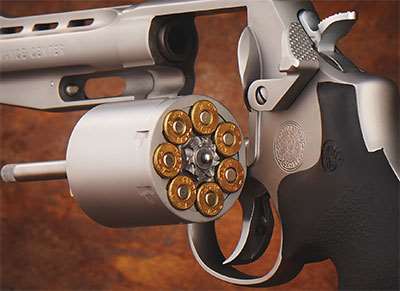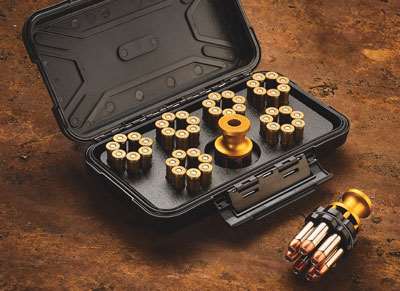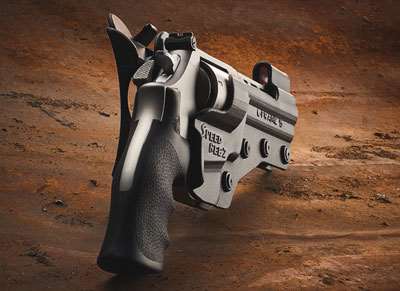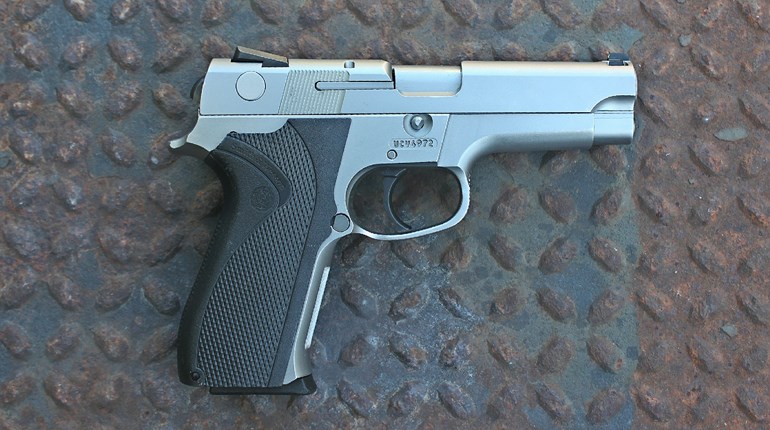
There’s an understandable temptation to dismiss an 80-something-year-old cartridge—and a firearm technology nearly twice that old—as yesteryear’s news. Even when offered by an august American marque like Smith & Wesson, just how compelling can such an artifact be? At the risk of a spoiler, “gigantic” is our rejoinder, and being hip-deep in the heyday of the auto-loading handgun does not dilute our enthusiasm. When modernist rationales and preferences are set upon by the likes of S&W’s Performance Center 686 Plus, it’s a surprisingly fair fight between the so-called “old” and the erstwhile “new.”
We concede at the outset that cosmetics have played a role in our assessment, because the matte-finished, stainless 686 is as handsome as could be. Up front is a vented, ribbed and half-lugged barrel of elegant proportion, complete with a swappable, all-orange sight blade. An unfluted cylinder is at the heart of the L-frame round butt, and hints at the size and strength of the cylinder needed to handle seven rounds of potent .357 Mag.
Rearward, more Performance Center touches greet the eye. An adjustable rear sight complements that distinctive front blade, while a massive cylinder release and chromed, teardrop hammer contribute the upper manifestations of the finely tuned action. The trigger—wide-faced and smooth—has an adjustable stop, and it stages beautifully to a 4.5-pound press for shooters who prefer this technique. Press-straight-through types will likely be just as happy (full travel press weight was just off our scale at what felt like 9 to 9.5 pounds), and we had no trouble with one-ragged-hole clusters using either method.
Using a selection of factory loads from 110 to 158 grains and hand loads from 105 to 200 grains in both calibers, accuracy and slightly surprising comfort were never hard to come by. A 38-ounce empty weight articulated with Hogue’s excellent Monogrip might seem the readiest explanation, and was undoubtedly true for .38 Spls. and softer confections of our own. Full-throated .357 Mag., however, is generally an unwelcome departure—it is our least-favorite conventional handgun fare—yet it, too, was rendered exhilarating rather than annoying by the 686.
Many satisfactions are neatly rolled up in the Performance Center 686 Plus. The most obvious is in small mountains of spent and piled brass; the most historical, perhaps, is the idea that 160-plus years in the revolver business have not dimmed Smith & Wesson’s aspirations to produce a superb product. But the grandest is surely the ongoing right of Americans to share with friends and neighbors a piece of handheld, thoroughly modernized history that both defends and attests to the truest liberty a people have ever enjoyed.
Nuts And Bolts

Reliability – Revolvers are rightly esteemed for providing a defensive sine qua non: In the deafening resound of an unexpected “click” (as opposed to “bang”), they offer the immediate remedy of another press of the trigger. Only double-action semi-automatics can even offer a second whack at the same likely defective cartridge (rare, we recognize, but not unknown), and single or DAO varieties often must be manually cycled to bring a new round into play. A 686 Plus, like other revolvers, will rotate new wherewithal into position and circumvent a host of worries with only one exception—seven predecessor trigger presses. If you’re out, you’re out, but that’s a different problem.

There’s an unhelpfully persistent notion that this same reliability equates to little or no requirement for maintenance. This is pointedly untrue and unwise, up to and including actual peril if there is potential for defensive employ. Any Smith revolver will give many tens of thousands of rounds of reliable service even with powerful ammunition (like “+P” .38 or .357 Mag. in the 686), but it’s important to understand that revolvers are more complex—arguably “delicate” in some mechanical senses—than autoloaders. The fix is to know how to keep their cylinder rotation and ejection mechanics clean, as well as to be able to spot issues like timing changes (proper alignment between the cylinder and barrel before hammer fall). If you choose to down power and shoot .38 Spl., maintenance will likely include some extra attention to keeping the chambers of the cylinder clean.

Versatility – Caliber interoperability has been one of the most appealing facets of the .38 Spl./.357 Mag. pairing since it was devised by Messrs Keith, Sharpe and Wesson prior to release in 1934. Lighter recoiling .38 remains a superb method for developing sound handgun technique with reduced recoil and wear (on both kit and shooter), yet it provides an avenue to defensive or hunting power at need. Factory loadings are diverse, but handloading in either case expands the versatility still more: From .22 LR-like recoil up to, as Philip Massaro said in American Hunter (April 2017), “serious bear medicine,” power levels can be increased so gradually that new shooters develop crucial sight-picture and trigger-press skills while recoil sensitivity usefully lags. Follow-through—the often-overlooked capstone of the skilled hand gunner—comes almost as a side effect.
Competition Beckons – USPSA Grand Master and Top 10 revolver hand Caleb Higby sent us Speed Beez accoutrement of an unmistakable sort to supplement our tests. Like many Smith & Wesson Performance Center firearms, the 686 Plus is out-of-of-the box ready for competition at a very high level. We found Steel Challenge a nearly perfect fit and particularly easy to keep moving along with the beautifully made Beez speed loaders, loading block and holster. Adding a few more loaders (either speed or moon clips) and belt gear, the 686 would also be admirably suited for ICORE or USPSA.


































